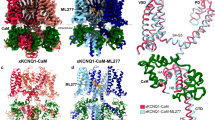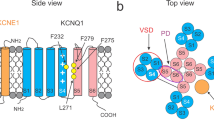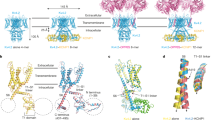Abstract
THE slowly activating delayed-rectifier K+ current, IKS, modulates the repolarization of cardiac action potentials. The molecular structure of the IKS channel is not known, but physiological data indicate that one component of theIKSchannel is minK (refs 1–6), a 130-amino-acid protein with a single putative transmembrane domain7. The size and structure of this protein is such that it is unlikely that minK alone forms functional channels8,9. We have previously used positional cloning techniques to define a new putative K+-channel gene, KVLQT110. Mutations in this gene cause long-QT syndrome, an inherited disorder that increases the risk of sudden death from cardiac arrhythmias. Here we show that KVLQT1 encodes a K+ channel with biophysical properties unlike other known cardiac currents. We considered that KVLQT1 might coassemble with another subunit to form func-tional channels in cardiac myocytes. Coexpression of KVLQT1 with minK induced a current that was almost identical to cardiac IKS. Therefore, KVLQT1 is the subunit that coassembles with minK to form IKS channels and IKS dysfunction is a cause of cardiac arrhythmia.
This is a preview of subscription content, access via your institution
Access options
Subscribe to this journal
Receive 51 print issues and online access
$199.00 per year
only $3.90 per issue
Buy this article
- Purchase on Springer Link
- Instant access to full article PDF
Prices may be subject to local taxes which are calculated during checkout
Similar content being viewed by others
References
Goldstein, S. A. N. & Miller, C. Neuron 7, 403–408 (1991).
Hausdorff, S. F., Goldstein, S. A. N., Rushin, E. E. & Miller, C. Biochemistry 30, 3341–3346 (1991).
Takumi, T. et al. J. Biol. Chem. 266, 22192–22198 (1991).
Busch, A. E., Varnum, M. D., North, R. A. & Adelman, J. P. Science 255, 1705–1707 (1992).
Wang, K.-W. & Goldstein, S. A. N. Neuron 14, 1303–1309 (1995).
Wang, K., Tai, K. & Goldstein, S. A. N. Neuron 16, 571–577 (1996).
Takumi, T., Ohkubo, H. & Nakanishi, S. Science 242, 1042–1045 (1988).
Attali, B. et al. Nature 365, 850–852 (1993).
Lesage, F. et al. Recept Channels 1, 143–152 (1993).
Wang, Q. et al. Nature Genet. 12, 17–23 (1996).
Heginbotham, L., Lu, Z., Abramson, T. & MacKinnon, R. Biophys. J. 66, 1061–1067 (1994).
Sanguinetti, M. C., Jiang, C., Curran, M. E. & Keating, M. T. Cell 81, 299–307 (1995).
Smith, P. L., Baukrowitz, T. & Yellen, G. Nature 379, 833–836 (1996).
Spector, P. S., Curran, M. E., Zou, A., Keating, M. T. & Sanguinetti, M. C. J. Gen. Physiol. 107, 611–619 (1996).
Li, G.-R., Feng, J., Yue, L., Carrier, M. & Nattel, S. Circ. Res. 78, 689–696 (1996).
Balser, J. R., Bennett, P. B. & Roden, D. M. J. Gen. Physiol. 96, 835–863 (1990).
Sanguinetti, M. C. & Jurkiewicz, N. K. J. Gen. Physiol. 96, 195–215 (1990).
Balser, J. R., Bennett, P. B., Hondeghem, L. M. & Roden, D. M. Circ. Res. 69, 519–529 (1991).
Matsuura, H., Ehara, T. & Imoto, Y. Pflugers Arch. 410, 596–603 (1987).
Cui, J., Kline, R. P., Pennefather, P. & Cohen, I. S. J. Gen. Physiol. 104, 87–105 (1994).
Curran, M. E. et al. Cell 80, 795–804 (1995).
Sanguinetti, M. C., Curran, M. E., Spector, P. S. & Keating, M. T. Proc. Natl Acad. Sci. USA 93, 2208–2212 (1996).
Author information
Authors and Affiliations
Rights and permissions
About this article
Cite this article
Sanguinetti, M., Curran, M., Zou, A. et al. Coassembly of KVLQT1 and minK (IsK) proteins to form cardiac IKS potassium channel. Nature 384, 80–83 (1996). https://doi.org/10.1038/384080a0
Received:
Accepted:
Issue Date:
DOI: https://doi.org/10.1038/384080a0
This article is cited by
-
Clinical and functional characterisation of a recurrent KCNQ1 variant in the Belgian population
Orphanet Journal of Rare Diseases (2023)
-
Ligand activation mechanisms of human KCNQ2 channel
Nature Communications (2023)
-
Computational Study on Effect of KCNQ1 P535T Mutation in a Cardiac Ventricular Tissue
The Journal of Membrane Biology (2023)
-
Gene mutations in comorbidity of epilepsy and arrhythmia
Journal of Neurology (2023)
-
KCNE1 does not shift TMEM16A from a Ca2+ dependent to a voltage dependent Cl- channel and is not expressed in renal proximal tubule
Pflügers Archiv - European Journal of Physiology (2023)
Comments
By submitting a comment you agree to abide by our Terms and Community Guidelines. If you find something abusive or that does not comply with our terms or guidelines please flag it as inappropriate.



